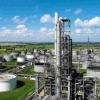I am assigned to design a hydrogenation pilot plant with process conditions as follows: P=70bar, T=230degC, H2 concentration>98%vol.
I have to make decision about material of construction of the equipments. I made reference to API 941 (the Nelson Curve) and found out that 0.5Mo low alloy steel could be used safely. Therefore, I proposed to my superior to use ASTM A-213 Grade T12 for tubing, A-335 Grade P12 for pipe, and A-387 Grade 12 for plate.
However, we wanted to use tubing system for the pilot equipments and I thought low alloy steel tubing might not be easily available, so I proposed the use of austenitic stainless steel (i.e., AISI304L) for the pilot and 0.5Mo steel for future the commercial scale equipments. I argued that using AISI304L would not give too much cost burden, given the small scale of the pilot plant.
There is senior mechanical engineer in my department who did not agree with me. He said 304L stainless steel should not be used for hydrogen service. Stanless steel is even more prone to hydrogen decarburization than carbon steel, he explained.
I presented the API 941 to him and pointed out that there is a note saying: "Austenitic stainless steel is generally not decarburized at any pressure and temperature". So, I could not accept his explanation. Needless to say, he insisted that I should use 0.5Mo in any case.
My questions are:
1. Is austenitic stainless steel safe for my application?
2. Do people choose 0.5Mo over stainless steel only because of cost factor (correct me if I'm wrong: 0.5Mo is cheaper than 304L) and not because of safety consideration?
Thank you.
xavio
Edited by xavio, 25 September 2012 - 12:57 AM.

 FB
FB











